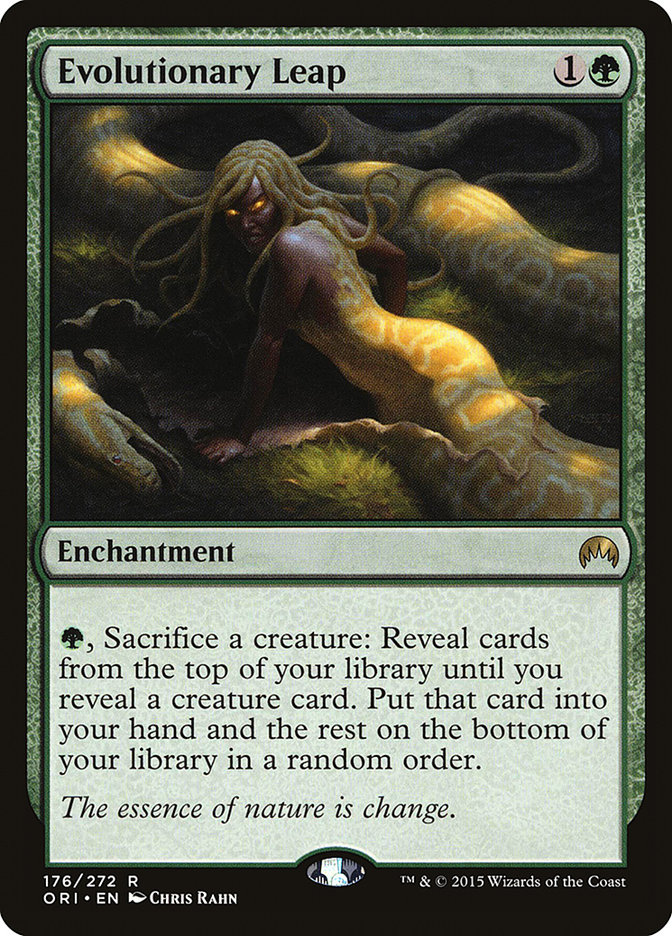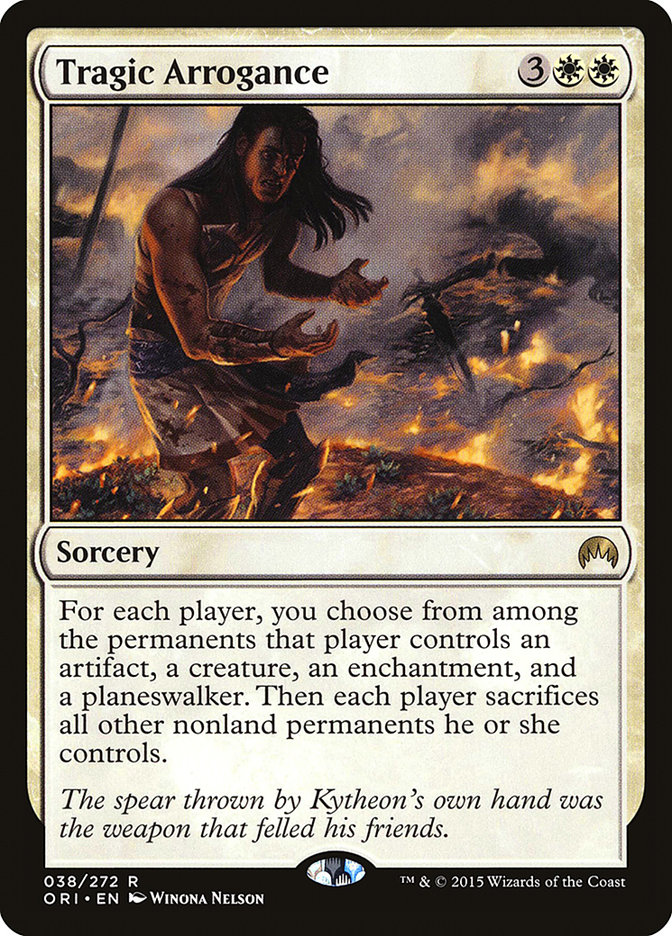So close, and yet so far.
For me, Pro Tour Magic Origins was an experience full of highs and lows – largely dependent on the format I happened to be playing at the time. I finished the event with a 9-1 record in the Standard portion, but I only managed to win one of my six draft rounds. When the Top Eight was announced and the decklists were posted on Saturday night, I couldn’t help but think that if I’d just been able to scrape together a few more draft wins I might have had a chance to take home my third Pro Tour title.
My preparation for this Pro Tour was different than most over the past few years. After being unhappy with my recent results, I decided that I wanted to try something different. I’d been testing with the core ChannelFireball group for quite a few years now, but recently I hadn’t felt as prepared as I might have liked. In particular, I was disappointed in my Constructed results at Pro Tours. Few people in that group were generally interested in working on the same kind of decks as me, which often resulted in me feeling like I was largely working on them alone. For this Pro Tour, I decided to try working with a different group in the hopes that might change.
The group that I joined up with for Pro Tour Magic Origins included many names with whom SCG readers are likely to be familiar. The roster included:
Brad Nelson
Gerry Thompson
Ari Lax
Tom Martell
Chris Fennell
Brian Braun-Duin
Ross Merriam
Steve Rubin
Michael Majors
Seth Manfield
Austin Bursavich
I had not worked with most of those players before, but I was excited to have a chance to play again with those I had. I’ve only worked with Gerry on a handful of occasions, but I’ve always found him to be open-minded and insightful while never getting too heavily invested in a particular idea or deck. Brad and I used to work together on CFB many years ago during his Player of the Year run, and he was one of my favorite playtest partners back then. He won that title primarily due to his tremendous work ethic, as he’s willing to put in tons of games to tune lists to perfection. His input was a huge part of refining several decks that I built over the years, including the Doran deck that we both played to Top Eight finishes at Pro Tour Amsterdam as well as the CounterCat Zoo deck we played at the first Modern Pro Tour in Philadelphia that brought Josh Utter-Leyton all the way to the finals.
That was the testing I was trying to replicate – the kind that took raw ideas and turned them into decks that won tournaments.
My first ideas for the Pro Tour were not tournament-winning ones. Initially, I was fixated on building decks with Archangel of Tithes and Knight of the White Orchid. The former was obviously an extremely powerful card based simply on its combination of stats and abilities, while the latter was a card that had been a standout in previous formats.
My infatuation with heavy white decks did not last very long. While Archangel was clearly powerful and could carry games by itself – especially against aggressive decks – the supporting cast just wasn’t doing enough. I tried a whole range of different builds, from Mono-White Aggro with a curve that ended at the Archangel to a Devotion deck that ramped to Wingmate Roc and Elspeth, to splashing blue, black, or green.
None of the lists ultimately impressed me. The white creatures simply weren’t good enough to compete. Cards like Knight of the White Orchid, Kytheon, and Relic Seeker were just embarrassing when they were up against Fleecemane Lion, Courser of Kruphix, or Deathmist Raptor. And even the higher-end creatures that weren’t Archangel were disappointing. Wingmate Roc, in particular, lost a huge part of its allure with the introduction of Languish, making it no longer a stone-cold killer against Abzan decks.
The best-performing of my experimental white decks was the W/G version, which splashed for Fleecemane Lion, Dromoka’s Command, and Den Protector – all of which happened to be the best cards in the deck. I decided that it just wasn’t worth trying to get the mana to work for Archangel of Tithes and went back to building a G/W deck that could actually use things like Elvish Mystic and Deathmist Raptor.
My early versions of the deck were pretty similar to the G/W Collected Company lists I’d messed around with during the last Standard season, with only Nissa, Vastwood Seer as a new addition. I liked the idea of Nissa as a tool to help assemble your mana early while also giving you more late-game power in attrition-based matchups. One of the things I’d found with G/W Company was that because it played so many cheap creatures to support Collected Company, it often just didn’t have enough raw power in the later stages of the game to beat cards like Elspeth, Ugin, or Dragonlord Ojutai, and I hoped that maybe Nissa could help with that.
My experience was that Nissa was great, and I liked the fact that I could find her with Collected Company in the late-game, but Company itself continually failed to impress me. I’d originally played it just as a sideboard card in my version of G/W in Brussels at Pro Tour Dragons of Tarkir, but the rise of Esper Dragons had seemingly turned it into a maindeck staple. I had never found it particularly exciting, since so many of the creatures in the deck were fairly low-impact in the mid- to late-game. While Fleecemane Lion or Deathmist Raptor were fine hits, you certainly weren’t excited to hit Elvish Mystic or Courser of Kruphix in most matchups, and you wanted to play every Den Protector that you could find face-down when games went long.
I’d thought that Collected Company would be important to beat decks with Languish, but it wasn’t even that exciting there. I felt like I had to get lucky to generate a meaningful board presence with it, and it was almost never enough to actually win a game that featured Languish into an Elspeth a few turns later.
Instead of Collected Company, I started to experiment with other cards that could allow me to develop my board without leaving myself open to Languish. One of those was Boon Satyr. I’ve always had a soft spot for Boon Satyr, because it’s a card that allows you to play in a bunch of different ways. It can simply be an end-step threat you play after a sweeper like Languish, it can be a trick to win creature combat or push for damage, and it can even be a way to save your creatures from removal – like Languish! The fact that the Bestow effect of Boon Satyr can keep a Fleecemane Lion or the like on the board by boosting its toughness above four against a Languish is a really big deal, and is a much more powerful response to the sweeper than digging with Collected Company.
I also tried Citadel Siege for much the same reason. It was a card I could play to boost my creatures both to put on extra pressure and to keep them out of Languish range. Siege was decent, but ultimately it felt quite weak against decks with a lot of spot removal. It was a terrible draw later in the game if I didn’t have a creature, and it felt really awkward to play into open mana and risk wasting my entire turn against a removal spell early on.
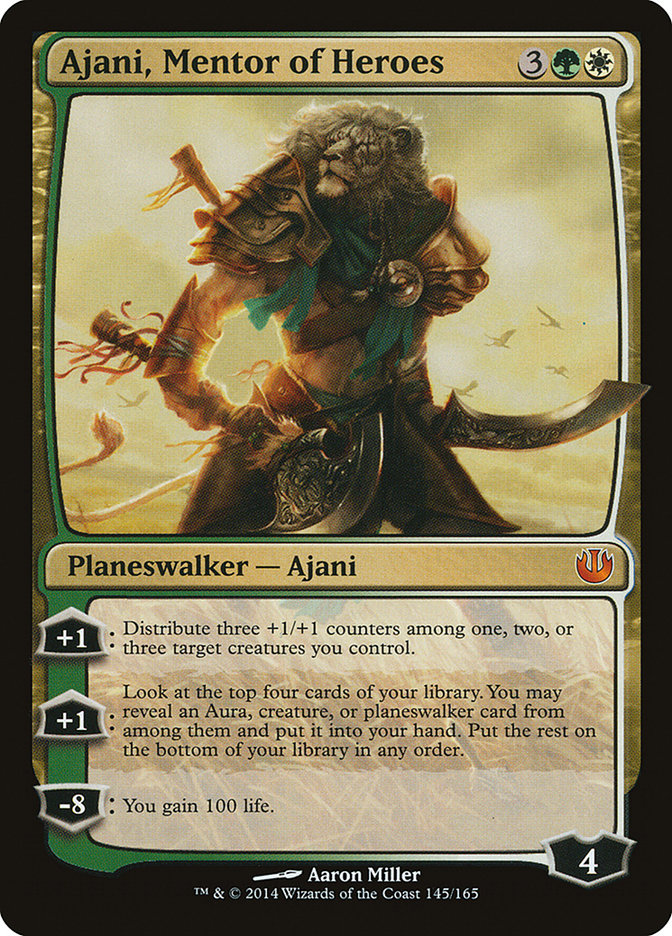 The card that I tried next to replace it, however, proved to be awesome: Ajani, Mentor of Heroes. Ajani is a card that I love to the point where I’ve even played it in Modern, so it’s always on my radar when I’m building decks. Given what I was looking for – a card that could offer additional late-game power along with an immediate board impact that could also help fight against Languish – it was perfect.
The card that I tried next to replace it, however, proved to be awesome: Ajani, Mentor of Heroes. Ajani is a card that I love to the point where I’ve even played it in Modern, so it’s always on my radar when I’m building decks. Given what I was looking for – a card that could offer additional late-game power along with an immediate board impact that could also help fight against Languish – it was perfect.
And while Ajani and Boon Satyr both offer tactical advantages in the way they line up against Languish, they both also have a much more straightforward purposes as well – killing the opponent. One of the most common ways I found myself winning was just loading up a Den Protector with a Boon Satyr or +1/+1 counters, allowing it to attack through even the most clogged boards. Against decks without a lot of spot removal, or even against those with plenty who just happen to tap out, you can quickly close out a game with a big unblockable Den Protector.
Here’s the deck I played in the Pro Tour:
Creatures (28)
- 4 Elvish Mystic
- 4 Fleecemane Lion
- 3 Boon Satyr
- 2 Courser of Kruphix
- 2 Warden of the First Tree
- 2 Hidden Dragonslayer
- 4 Den Protector
- 4 Deathmist Raptor
- 3 Nissa, Vastwood Seer
Planeswalkers (2)
Lands (10)
Spells (20)

The Hidden Dragonslayers were the last cards I decided on in my maindeck. I wanted a bit more interaction against decks with big creatures like G/R Devotion as well as a few more early plays in games where I didn’t draw Elvish Mystic. Hidden Dragonslayer overlaps with those two needs perfectly while also serving as a must-kill creature for red decks as well as a way to bring back Deathmist Raptor.
The sideboard was awesome, with Hangarback Walker as the all-star contributor. While my team did not independently build the U/R Thopters deck that made such a splash at the Pro Tour, we did recognize the power of Hangarback Walker pretty early on, and were experimenting with it in a number of different decks. I realized that it was a perfect fit for my sideboard since it helped provide sweeper insurance against control while also serving as a strong early blocker against aggressive red decks. It’s rare to find a card that performs well against polar opposites of the spectrum but Walker did exactly that, replacing the weaker cards in each matchup quite well after sideboarding.
Hangarback Walker helps with so many situations against control it’s kind of outrageous. It’s a threat that can leave behind a presence against sweeper effects, it counters multiple copies of Foul-Tongue Invocation, it can generate fliers to kill Elspeth, and it’s even colorless so it can’t be exiled by Ugin – all of these came up in testing, and many in the Pro Tour itself. Hangarback Walker also pairs extremely well with my other sideboard card against control, Evolutionary Leap. Evolutionary Leap turns all of your opponent’s spot removal into cantrips for you since you can just dig for a new creature every time they try to kill one. You can protect your Deathmist Raptors from things like Ugin or Perilous Vault, and you can turn a Hangarback Walker into nearly drawing your entire deck.
Tragic Arrogance was a card that was on my radar from the moment I read it on the spoiler – even after I realized that no, WotC did not just up and reprint Cataclysm, you don’t get to kill lands with it. The big impact of Tragic Arrogance is the ability to beat creature-mana based ramp decks like G/R Devotion, which can otherwise be big trouble for G/W midrange-style decks. Tragic Arrogance can wipe out your opponent’s entire board down to a single mana creature while keeping your own best creature – and often an enchantment creature as well. It’s also quite strong against U/R Thopters, since you can do the same against their swarms of creatures. Keep in mind, though, that you can’t force them to sacrifice lands, so Darksteel Citadel will always survive. And don’t cast it against an active Whisperwood Elemental, because that will generally go very badly for you.
Unravel the Aether was a fairly last-minute addition. I was planning on playing one or two copies because I was sure that there would be other decks with Hangarback Walker and it’s one of the few ways to remove it without giving your opponent Thopters. When I got wind that U/R Thopters was going to be a popular deck, I decided to hedge my bets and play three copies since it’s obviously incredibly powerful against Ensoul Artifact, even on a Darksteel Citadel. Amusingly enough, U/R Thopters ended up being my one loss in the tournament, in large part due to the fact that I didn’t know what to expect from the deck and ended up throwing away a Den Protector into a Wild Slash by trying to play it ultra-efficiently rather than saving it until I could turn it face-up immediately.
The only cards in my sideboard that didn’t end up performing well in the tournament were Hushwing Gryff and Glare of Heresy. Hushwing Gryff was intended as a tool against Dragonlord Atarka, Constellation decks, and Rally the Ancestors. I never played against the latter two, and my only match against a deck with Atarka never saw her enter the battlefield. I didn’t play against a single Abzan deck in the tournament, so I never brought in Glare of Heresy, but it’s primarily there as a tool against Elspeth – the single best card in the format against this deck. You can beat it, especially with Hangarback Walker plus Evolutionary Leap, but Glare is a nice insurance policy if things don’t come together for you otherwise.
I’d probably cut Hushwing Gryff moving forward, probably for the fourth Dromoka’s Command to solidify things even more against red and U/R Thopters, and maybe for a second Glare to help fight against Elspeth.
I’m generally not a fan of strict sideboard plans, since I think it’s important to adjust based on your opponent’s specific list, but here’s a general idea of your best and worst cards against some of the most popular decks:
VS Mono-Red
Out:
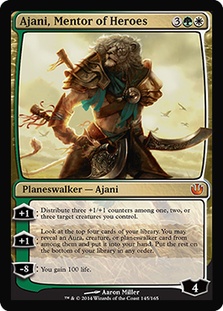

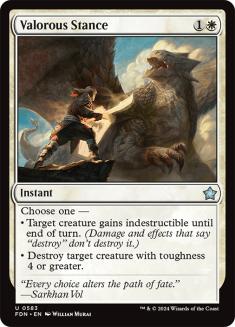

In:
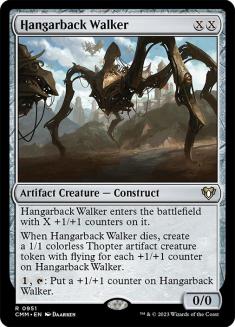



Ajani is expensive, even if his ultimate wins the game, and Stance doesn’t really have great targets. I’d cut the third Stance for the fourth Command if it’s in the sideboard, and bring in all four Hangarback Walkers as speed bumps to absorb early damage.
VS U/B or Esper Control
Out:
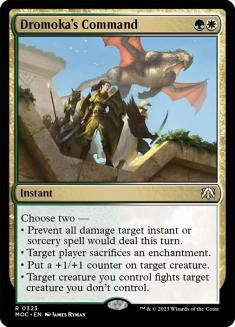



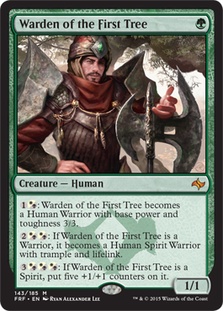

I could also see taking out two copies of Hidden Dragonslayer instead of Warden of the First Tree.
In:




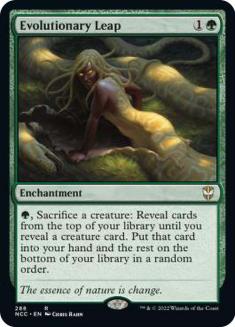

This depends on the specifics of the opponent’s deck, because Valorous Stance is actually good against decks without many copies of Bile Blight or Languish, and you want Unravel the AEther against opponents with Perilous Vault. Warden of the First Tree isn’t very good in matchups where it’s facing a lot of removal, though it’s a bigger threat than Hidden Dragonslayer against decks where you think you might face Drown in Sorrow.
VS Abzan Control
Out:





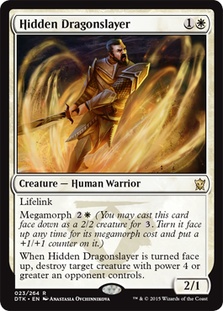

In:






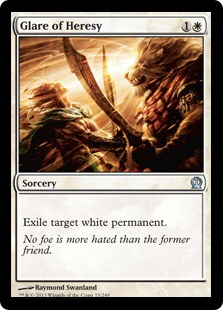
This one is pretty makeup-specific because if the opponent has Tasigurs and Coursers, you definitely want all of your Valorous Stances. It’s important that you don’t get a draw that is too reactive, though, so I like keeping a mix of Dragonslayer/Stance most of the time.
VS G/R Devotion
Out:



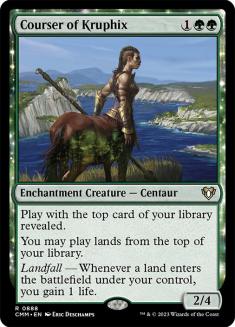

In:

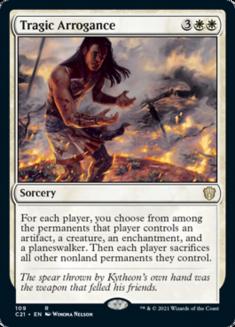

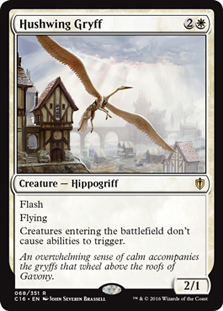

I like a couple copies of Dromoka’s Command since it’s nice for taking out Courser or fighting mana creatures, but it’s not a card you want to draw in multiples. Warden gets blocked by Courser/Raptor/Whisperwood and isn’t worth the mana investment, while your own Coursers just aren’t impactful enough in how the game plays out. You mostly want to just try to get as much value out of Valorous Stance and Den Protector as you can, and try to get off a crippling Tragic Arrogance. Always watch out for Dragonlord Atarka and keep in mind their mana count with a potential Nykthos – it may be worth using removal on something that might not seem like the biggest threat in order to keep them off of being able to get to seven mana.
VS U/R Thopters
Out:



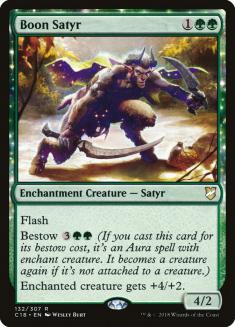

In:
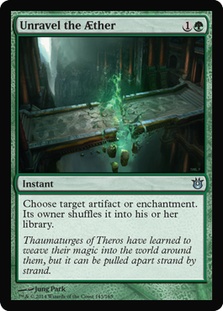




I’m not totally set on this sideboard plan because I haven’t actually played this matchup all that much. This is another place you want an extra Dromoka’s Command if you have it. I can easily see cutting all of the Valorous Stances, because it only hits Ensoul Artifact and you have a lot of ways to remove that, but an early 5/5 is probably their best way to beat you so you might not want to cut all of your ways to kill it. Boon Satyr seems like best creature to cut, but maybe you just want to cut one copy of Nissa since she doesn’t really block anything and the games don’t really go super long and let her have a major impact.
All told, I think this deck is great, and I’d play the exact same thing in the Pro Tour again if I could go back in time a week. I might make a few different draft picks, or play a few of those games differently, but I’d be happy to run the Pro Tour back with the same 75 cards – and that’s not something I say lightly. Usually I look forward to the Grand Prix after a Pro Tour in the same format as a chance to fix my mistakes, but I’m excited for San Diego to give me a chance to show that I was right all along. If you’re looking for a Standard deck that crushes Mono-Red and has all the tools to beat the other top decks in the metagame, I suggest you come along with me for the ride.


